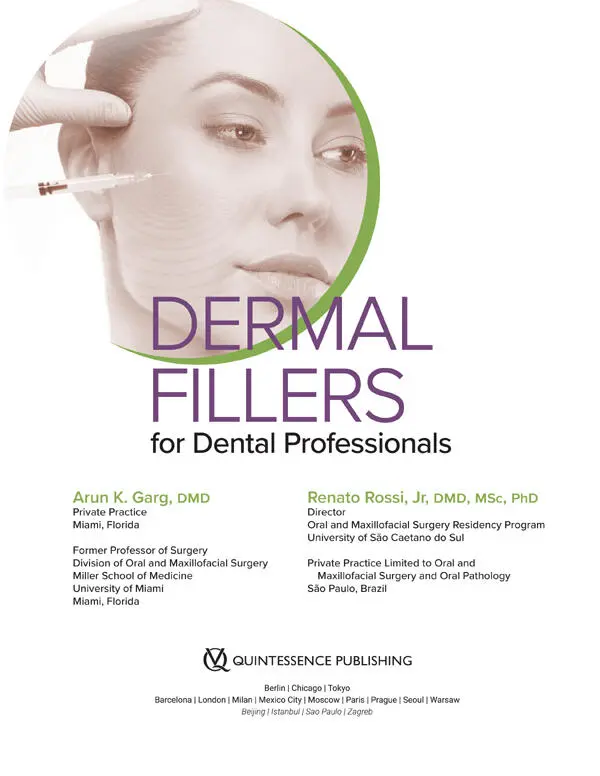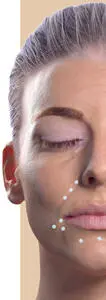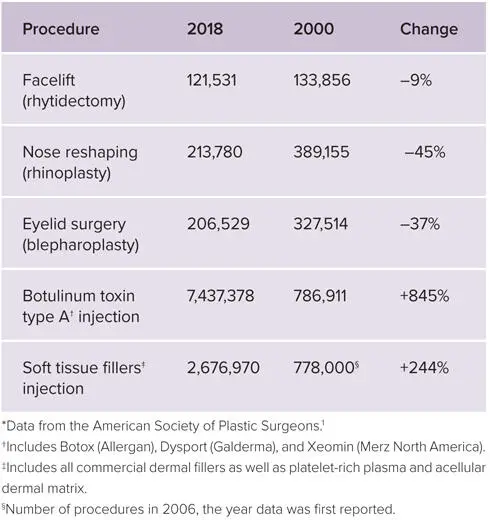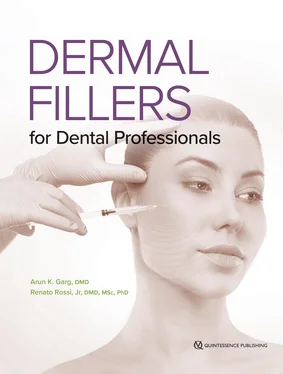Dermal Fillers for Dental Professionals

Library of Congress Cataloging-in-Publication Data
Names: Garg, Arun K., 1960- author. | Rossi, Renato, Jr. author.
Title: Dermal fillers for dental professionals / Arun K. Garg, Renato Rossi, Jr.
Description: Batavia, IL : Quintessence Publishing Co, Inc, [2021] | Includes bibliographical references and index. | Summary: “In-depth clinical manual covering everything dental providers need to know to provide dermal filler treatment, including specific filler products, skin anatomy review, and a step-by-step guide on specific procedures accompanied by case examples”--Provided by publisher.
Identifiers: LCCN 2020050330 (print) | LCCN 2020050331 (ebook) | ISBN 9781647241070 (hardcover) | ISBN 9781647241087 (ebook)
Subjects: MESH: Dermal Fillers | Cosmetic Techniques | Esthetics, Dental | Injections, Subcutaneous--methods | Dermatologic Surgical Procedures
Classification: LCC RK54 (print) | LCC RK54 (ebook) | NLM WE 705 | DDC 617.6--dc23
LC record available at https://lccn.loc.gov/2020050330
LC ebook record available at https://lccn.loc.gov/2020050331

© 2021 Quintessence Publishing Co, Inc
Quintessence Publishing Co, Inc
411 N Raddant Road
Batavia, IL 60510
www.quintpub.com
5 4 3 2 1
All rights reserved. This book or any part thereof may not be reproduced, stored in a retrieval system, or transmitted in any form or by any means, electronic, mechanical, photocopying, or otherwise, without prior written permission of the publisher.
Editor: Marieke Zaffron
Design: Sue Zubek
Production: Sarah Minor
Printed in the United States
Contents
preface
SECTION I: Getting Started with Dermal Filler Treatment
1 Dermal Fillers: What Every Dentist Should Know
2 Anesthesia for Dermal Filler Injections
3 Dermal Filler Selection
4 Preventing, Avoiding, and Managing Complications
5 Esthetic Consultation and Treatment Plan
6 Dermal Microneedling
7 Planes of Injection and Injection Techniques
SECTION II: Step-by-Step Procedures
8 Green-Light Procedures
9 Yellow-Light Procedures
10Red-Light Procedures
index
Preface
This book presents a clinical experience–based framework for the incorporation of dermal fillers for facial rejuvenation procedures into a general dental practice or dental specialty practice. These procedures are a natural progression in the evolution of cosmetic dentistry. The dentist’s and dental specialist’s existing skill set of esthetic assessment, administration of local anesthesia, and making patients comfortable in the office setting make this type of treatment fairly easy to incorporate into the practice routine.
Today, providing dermal filler and/or cosmetic neurotoxin injections is permitted by an overwhelming majority of the state dental licensing boards in the United States and abroad. What’s more, the American Dental Association and state associations have been sponsoring courses that train dentists in these procedures for many years. And why not? Under U.S. medical licensing guidelines, any physician with a medical degree from an accredited institution—regardless of specialty—can offer cosmetic facial injections as a service to their patients with no additional training. Does anyone really believe that the average obstetrician or rheumatologist has greater expertise in facial anatomy than a dentist? What about estheticians? In some states, an individual with no medical education can take a weekend course and then give facial injections, provided they are under the “delegation” of a physician.
Dental training and skills make the group exceedingly well qualified to provide safe and esthetically pleasing dermal filler injections. Like most dental procedures, administering facial injections for cosmetic purposes requires a combination of excellent technical and artistic skills, as well as comprehensive understanding of head and neck anatomy and knowledge of current materials and treatment modalities.
We are certainly not suggesting that the average dentist or dental specialist does not require additional training to learn how to select an appropriate dermal filler product, practice safe facial injection techniques, or prevent complications. On the contrary, our goal in writing this book is to provide the information that the dental clinician needs—and none of the information that dentists, by virtue of their training, already possess—to become qualified providers in the highly rewarding (and potentially lucrative) area of facial rejuvenation.
The scope of dental and dental specialty practice has never been static. The purpose of this book is not to promote the need for all dentists and dental specialists to provide these cosmetic services. But rather the objective is to present how numerous dermal filler procedures can be successfully and safely incorporated into an existing practice using the model that we, as both practicing clinicians and academicians, have developed and taught to hundreds of others over many years.
Section I: Getting Started with Dermal Filler Treatment

1
Dermal Fillers: What Every Dentist Should Know
The term facial rejuvenation refers to several different categories of treatments designed to improve the appearance of the face: plastic surgery such as rhinoplasty, blepharoplasty, and rhytidectomy; less invasive procedures such as dermal abrasions and chemical peels; and the growing list of minimally invasive therapies, including laser skin resurfacing, microdermabrasion, neurotoxin injections, and dermal filler injections (Fig 1-1). In 2019, the American Society of Plastic Surgeons reported that from 2000 to 2018, the number of facelift surgeries declined 9%, while the number of neurotoxin injections increased an astronomical 845%. Similarly, dermal filler treatments have increased 244% since 2006, the first year for which data were collected ( Table 1-1). 1 As these numbers demonstrate, neurotoxins and dermal fillers have radically changed the market for facial rejuvenation procedures in the United States, and this trend will continue to increase at least for the next several years.

FIG 1-1 Facial rejuvenation is a term that encompasses esthetic procedures in plastic surgery, nonsurgical procedures such as dermal abrasion and chemical peeling, and minimally invasive procedures such as neurotoxin and dermal fillers.
TABLE 1-1Facial cosmetic procedure trends in the United States since 2000*

Some of the reasons for this trend are obvious. Neurotoxins such as Botox Cosmetic (Allergan) and Dysport (Galderma) and dermal fillers can usually be administered in less than an hour, produce effects that are apparent immediately or within days, and require little or no downtime. Moreover, these esthetic enhancements are subtle enough not to attract attention and thus can be undertaken discreetly, which many people appreciate. Indeed, the intent of these procedures is not to make a person look 20 years younger but rather for them to appear more radiant and refreshed at their present age (Fig 1-2).
Читать дальше

















